Syria: Hama, Afamea, Krak des Chevaliers

December 30, 2003
I awoke early in the morning with the decision to go to Afamea firmly in my head. Emily left to get some breakfast shortly before I set out and, as I she was moving on to Aleppo, I would not see her again. As it was light out and I had oriented myself to the town, I was able to walk through the colorful streets of Hama, well deserted at this early hour, to the bus station in only about 15 minutes. The bus station, like all in the Middle East, it seems, it a large square area with mini buses, luxury buses, and taxis parked everywhere and without, to my uninformed eyes, any particular pattern. If you didn't know where the buses to Afamea were, you just had to ask. I realized that I had traveled roughly in the right direction last night, but had veered off too far to the left, which resulted in my very pleasant evening stroll.
I found a mini bus heading toward Afamea and hopped aboard, though it was another twenty minutes before it filled enough for the driver to leave. There isn't a direct connection to Afamea (which is out in the sticks, even by Syrian standards), but the mini took me to Squilibya (pronounciation) for 20 pounds, were I was able to find another mini to take me to Al Mudiq for another 10 pounds. Al Mudiq was a dirty industrial town with little to recommend it, other than the fact that Afamea was about a kilometer walk up hill from it. I enjoyed being able to stretch my legs in the countryside, particularly as Al Mudiq was fairly well bounded and I quickly got out into green farms and rolling hills. Thick clouds were overhead and the place felt like, I imagine, Ireland or England, rather than the dry Syrian countryside. The ruins were spread out, with three quarters on one side of a road, and the other quarter on the other. As there was no one at the shack that took admission fees, I decided to poke around the smaller part first and then return later to pay.

Afamea is another ruined Roman city that would be the star attraction of Syria if it wasn't for places like Palmyra and Bosra. Unique, it seems, to Afamea (also spelled and pronounced Apamea) is the heavy use of fluted columns. There was a Syrian (or Lebanese or Jordanian, for all I knew) couple with a guide, but they were the only other tourists other than myself. After exploring for an hour or so, I returned to the road and found a man in the shack. He didn't have change, so I left a large bill and said I'd come back later for the change. The other side of the ruins was quite extensive, but there were few of the side-ruins that made Bosra and Palmyra so fun to explore. Mostly what Afamea offered was a long, long street, with many columns and some interesting relief work. The atmosphere was just right, however, and I thoroughly enjoyed the three hours I spent in the ruins. When I reached the end of the ruins, I climbed a small hill and watched a farmer plowing his field, which ran up to within meters of the ruins.
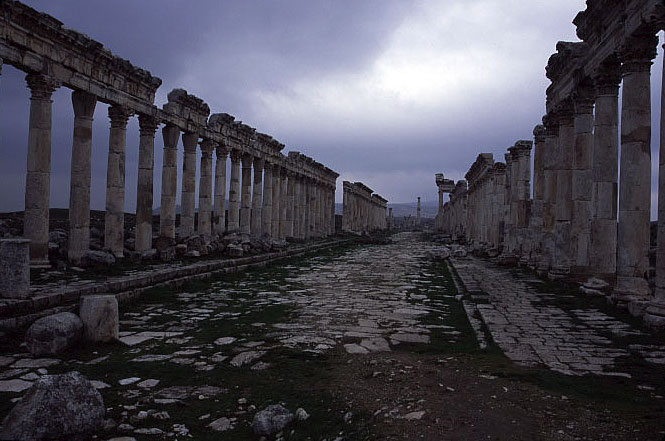
I wandered back down through the ruins, passing a different couple-with-guide on the way, and collected my change from the entrance booth. The stroll through the countryside back down to Al Mudiq was just as pleasant as before and I couldn't imagine why people would ever take a taxi. There don't seem to be any dogs in Syria to make trouble and you meet a few people whom you wouldn't ordinarily talk to. Because I was on foot, I seemed to be less of a touron in the eyes of the local farmers, although I don't think the concept of walking just to walk is one that seems normal to them. Back in Al Mudiq I caught a mini, this time for 5 pounds, to Squilibya, where I found a small street side cafe and had some shawarma before looking for a ride back to Hama. The only minis I could find took me first to Homs, where I had to depart and find another mini to Hama. No problems now. I was getting good at the whole mini thing.
The mini dropped me off somewhere in Hama other than the main bus station but, as it was on top of a large hill, I didn't worry too much about finding my way back to the Cairo. I sat on a wall for a while doing nothing, and attracted no attention from passers-by. Having worked over where I probably was, I set off down the hill and wandered about for about ten minutes before I recognized a certain overpass and was able to find my way home. I rested for a couple of hours and, as it was still early in the afternoon, went off on a two hour walk through Hama itself.
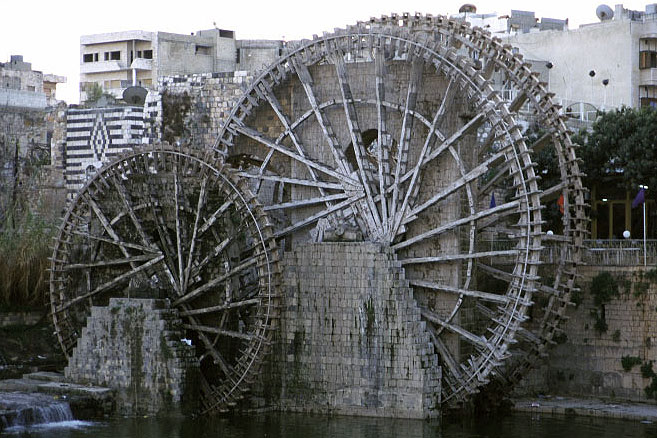
Hama is famous for its Nourias, which are old Roman waterwheels, placed along the river that runs through town. I walked along the river and spotted a couple of nice ones, though the views of them were obscured by the various restaurants that lined the river bank. I crossed the river on a bridge and headed back in the other direction. A teen on a moped pulled up along side me as I was walking and we went through a broken discussion in my weak Arabic before he proceeded to wheelie his moped for me a few times. After the third or fourth pass, he headed off to join a group of school boys and I waved goodbye.
The other side of the river held better views of the nourias and even a splendid park, where I sat for a while doing nothing at all. I noticed that there were alot of people in the park, all local, doing the same thing that I was doing. In the States, people just don't go and sit in parks to do nothing. Generally, the people there are either with someone else, or are vagrants. I liked having a bench to sit on in the park and I wished that there were more opportunities to do nothing in the US like I was doing now in Syria.
I walk alongside the river for a while longer and then poked around a few local mosques before returning to the Cairo for a brief nap. Emily was gone and hadn't been replaced my a new room mate so I had the place to myself. I counted my money and found that I had far more Syrian pounds than I realized. Given that the pound is hard to convert, I resolved to waste some money by staying in a fancy place for a few nights in Aleppo.
When it was dark out, I went out for a stroll in search of more shawarma and felafel and pastries. Hama has a very nice one that is sort of like a piece of cake. The top is crunchy and sweet, while the bottom is a moist sweet cheese of sorts. The pastry is cooked in large circular pans and then cut up for customers. A large dose of honey syrup is poured over the top and the entire thing is guaranteed to satisfy any sweet tooth. I returned, sated, to the Cairo and watched the BBC for a while before adjourning to the open roof top of the Cairo. During the summer time, truly budget travelers are allowed to sleep up here, but there was no one staying it the open air during the winter. I sat in the evening air and watched the traffic go by, waiting for the evening call to prayers from a mosque close by. The muezzhin began his call and listened as he went through the entire thing. And then the city was quiet once again. I left the roof top for my bed, calm and content.
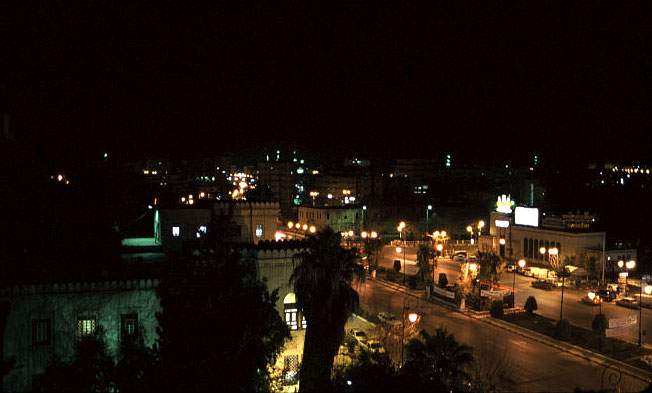
I wanted to get an early start for the day as my guidebook made the trip out to Krak des Chevaliers to sound like something of an ordeal and I was hoping to get in before too many tourists showed up. I left the Cairo a little after 7 am and walked back down to the bus stop, passing the various shops just as they were opening. Unfortunately, the notion of a large coffee to go hasn't yet reached this part of the world, no matter how many coffee beans I passed along the way. Although I did have to take two mini buses to get there, I rolled up to the outer wall of the Krak around 9:30 after spending 45 pounds, much faster and much cheaper than I had anticipated. The Krak, once called the world's greatest castle by a man who knew about such things, stands as a monument to the Crusdaders who helped bring it into existence.
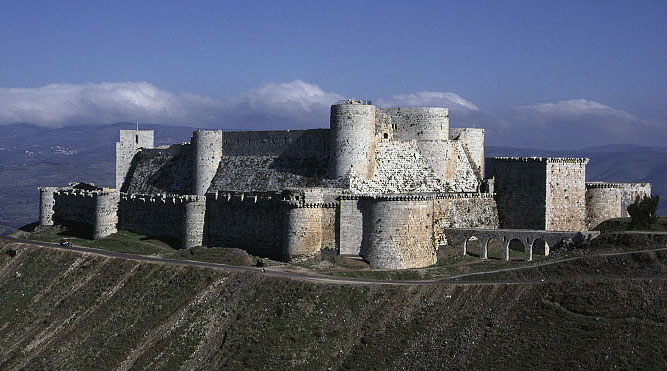
A chain of mountains runs down close to the coast of the Levant with only a few breaks. Anyone wishing to bring something large, like an army, from one side to the other (i.e, from the sea to the interior or vice-versa) has to go through one of these few passes. The Krak was built on a hill overlooking one such gap and was thus very important from a strategic viewpoint: Whoever held the Krak also controlled the pass. Massively built, the Krak was never conquered by the armies of Islam. Rather the Crusaders, worn down by warfare, eventually retired and sailed away.
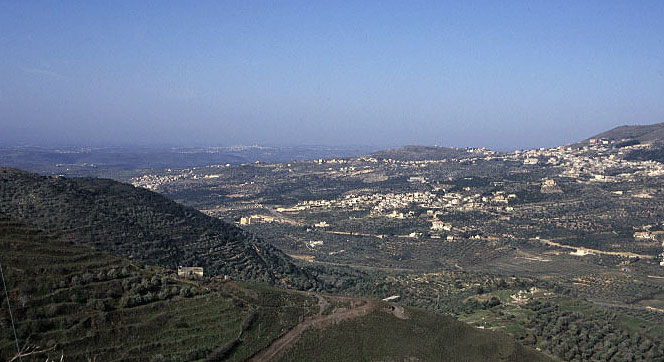
I began by walking around the outer walls of the castle, exploring all the little side rooms, passageways, towers, and turrets. As with other monuments, there were no ropes or boundaries to keep tourists out. However, very few of the areas were lit and I was glad that I had brought a small LED light so that I explore them all. Although I tried, a complete walking circuit of the tops of the outer walls is not possible as there are towers and turrets that block progress, along with some small gaps. I got to within 10 meters of the starting point of my tour before retracing my steps.
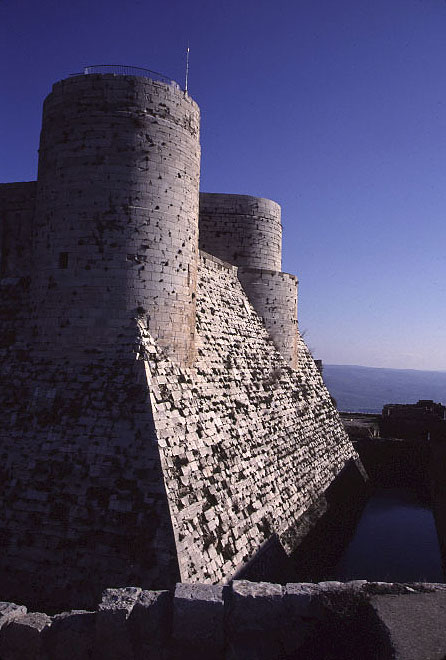
The outer walls were the first line of defense, but not the last. Even if an attacked managed to penetrate into the outer set of walls, and battle through all of the defenders who would fill the passageways, they were only part of the way done. They would then have to cross a courtyard and then deal with the second set of walls, behind which were more defenders and all of their supplies.
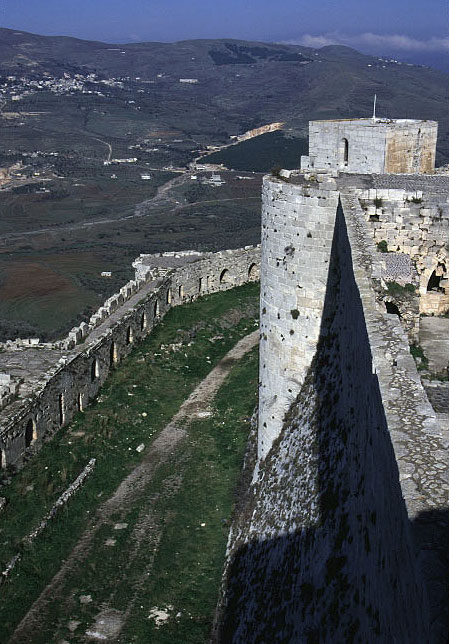
I explored the no-mans-land in between the inner and outer walls for a while and realized, after emerging from one particularly dark and dank tunnel, that I had spent two hours and hadn't even gotten inside the castle proper. Tourists had arrived now, but most were with guides of some sort and they tended to stay in the well lit areas and didn't linger in any one place for long. Even though there were people out, I couldn't imagine what the crowds would be like if the Krak was located in Germany, say, instead of Syria. After poking around some underground baths that were accessed from the no-mans-land, I proceeded inside the main walls, where most of the other tourists, and their guides, were milling about and learning some history.

I walked through the inner set of wall, exploring the guts of the castle and all it held. Frequently I would come out of a dark passageway and into a main room, surprisingly a group of tourists and their guide. Because the connecting passageways were frequently pitch black, organized groups wouldn't go into them. I had a flashlight, and no schedule, so I went where I pleased. After finding the oil-storage room (I can't remember why I thought it important to find it), I returned to a particularly quiet and uninhabited part of the inner walls that I remembered passing and sat in a window for a while resting and soaking up the excellent weather. The wind was blowing stiffly, and there was some haze, but the view out into the plains was immense.

After a thirty minute rest and cookie-eating session, I returned to the rest of the castle and the increasing number of tour groups. After Afamea, any more than a handful of tourists (in reality what there was at the Krak) seemed like a crowd. I located the chapel for the castle, which had the distinction of being the only non-military structure in the entire Krak, the rest being devoted to some facet of the garrison. However, a rational person might argue that in a thing like the Crusades, religion and the military were tightly bound. There was nothing in the chapel of interest except for a nice beam of light, which oddly enough was quite satisfactory.

I made the final climb up to the highest tower, but the thrill of the Krak was gone. I had seen plenty of it and was a bit weary from all the exploring I had done. Moreover, the tower held a dozen or so tourists, including several Dutch who were wheezing there way up the metal staircase. I think there were something like forty steps.

I dropped down to the outer walls of the castle and walked out to a near hill where I could get a view of the entire place and take a long rest without being disturbed. Indeed, after taking a few photos, I napped in the sun for twenty minutes or so and woke up feeling fresh and new and ready to face the mini rides back to Hama. I started to walk back into town, but near the Krak and old man waved to me and two French women that the mini buses departed from a particular sign. Slightly dubious as to this, the three of us went and stood by the sign. A mini bus pulled up and wanted a fairly outrageous sum to take us to Homs. Knowing full well that we could walk less than a kilometer downhill and pick up a mini bus for a reasonable rate, the three of us bargined for a while and eventually got the price down to 50 pounds each, which was twice what I had paid to get here from Homs. But, the ride was fast and smooth and I had the French women to talk to. They were traveling in a slightly different method than I was. I asked them for a recommendation of a place to stay in Aleppo and they thought the cheapest, sleaziest place I could find would cost me $30 a night. I found this somewhat suspect and they were a bit shocked when I told them that I was staying for less than $4 a night in great place in Hama. I don't think they quite believed the "great" place part, and that made us even.
I transfered to another mini bus in Homs and arrived back at the Cairo a little before three. Tired from all my tramping about, I took another nap until near nightfall, when I woke up with a fierce hunger. I realized that today was New Years Eve, the third in a row that I'd spent beyond the borders of the US. Tomorrow I had planned on going to an Ismaeli castle called Musyaf, but being a holiday I thought transit might be a problem, particularly as Musyaf was a bit out of the way. Even more of problem, the day after that was a Friday, and nothing much happens on a Friday unless you are a Muslim. For dinner I went out to a nice restaurant and was grossly overcharged, but the food was tasty and I got to have some raw lamb minced up with herbs and drizzled in olive oil, which seems to be something of a local delicacy. I was happy to do it once, but I can't imagine that the 600 pounds I spent on dinner was really justified, particularly as 100 pounds would buy me a shawarma, a felafel, a soda, and a quarter kilo of pastries. I made a spot decision to go to Aleppo tomorrow, as I would then get to spend Friday in a new, large city. I was looking forward to Aleppo and an extra day there certainly wouldn't hurt me any. I returned to the Cairo and retired to the pleasant roof top to wait for the muezzhin and to drink down the remainder of the arak I had bought the night before last.













